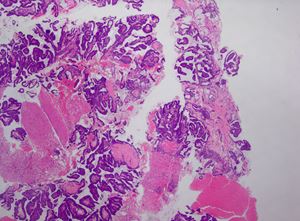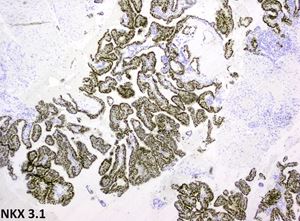CASE OF THE WEEK
2019-14 / MAY 20
(CONTRIBUTOR: ASLI YILMAZ, YUAN GAO)
84-year-old male with a history of follicular lymphoma, melanoma, and a 3.6 cm kidney mass, present with inguinal lymphadenopathy. Images are from biopsy of left inguinal lymph node.
Quiz
What is the correct diagnosis?
a. Follicular lymphoma
b. Metastatic melanoma
c. Metastatic papillary renal cell carcinoma
d. Metastatic prostatic ductal adenocarcinoma
1. d
Metastatic prostatic ductal adenocarcinoma
Ductal adenocarcinoma is a variant of prostatic adenocarcinoma characterized by papillary, cribriform, solid or glandular architecture composed of pseudostratified columnar epithelium. This variant may be pure or mixed with acinar adenocarcinoma. It may involve the peripheral zone in which case it gets detected on core biopsies, or it can have a central periurethral location resulting in lower urinary tract symptoms, urinary obstruction or hematuria. Ductal adenocarcinoma is associated with advanced stage and higher rate of metastases including to visceral organs such as the lung, brain and liver. Therefore, in terms of grading, most cases are given a Gleason grade 4 or 5 (in the presence of comedonecrosis). One exception is the PIN-like variant which was found to have a prognosis comparable to Gleason pattern 3.
PIN-like (Ductal) Adenocarcinoma of the Prostate. Paulk A, Giannico G, Epstein JI.
Am J Surg Pathol. 2018; 42(12):1693-1700.
Ductal adenocarcinoma of the prostate: histogenesis, biology and clinicopathological features. Seipel AH, Delahunt B, Samaratunga H, Egevad L.
Pathology. 2016;48 (5): 398-405.
Asli Yilmaz, Yuan Gao
University of Calgary
Yuanny@gmail.com
Lymph node, Prostate
ductal





